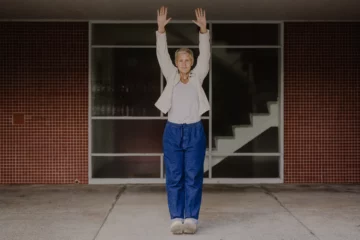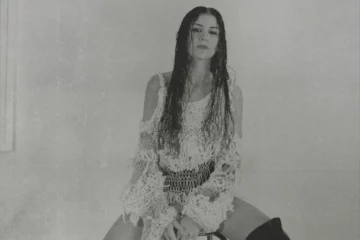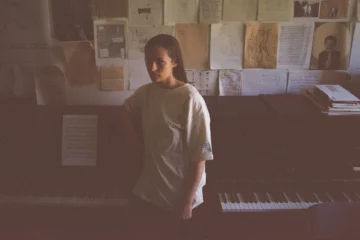»This is not entertainment«. Those were the words written in 1961 on a door in Chamber Street 112, New York. In a loft, 27-year-old Yoko Ono and La Monte Young were organizing a series of concerts. Only three people attended the first show. John Cage was one of them. Peggy Guggenheim, Max Ernst, and Marcel Duchamp showed up during the »second or third« session. Over the course of the next years, this series gave birth to the Fluxus movement. La Monte Young provided them with a kick-off by co-editing the »Anthology of Chance Operations«. Yet, he himself was increasingly drawn to minimal compositions. Young performed with Terry Riley. Part of his ensemble were John Cale and Angus MaxLise, two founding members of The Velvet Underground.
It’s no exaggeration to describe La Monte Young as a key figure in modern art history. His teachers were Karlheinz Stockhausen and students of Stravinsky and Charlie Parker, respectively. Young is often referred to as the founding father of minimal music. Without him, drone wouldn’t be a genre. Cale cited Young as »the best part of my musical education«. Lou Reed situated himself »vis a vis La Monte Young’s Dream Music« in the liner notes to his instrumental album »Metal Machine Music«. Due to Young’s excessive use of feedback, he can be considered a precursor of shoegaze. He fostered the reception of Hindustani music in the West years before the Beatles did. Via his collaborator Jon Hassell, Young has influenced the development of world music. Ambient pope Brian Eno reportedly called Young »the Daddy of us all«.
The Great Unknown
Despite all of this, most of our readers won’t have heard a piece by La Monte Young. (At least, I hadn’t until I was humbled by Scanner and Gareth Davis last year.) This is partly due to Young himself: he rarely ever performs. The Mela foundation counts a mere 17 authorized recordings, most of them being excerpts. When the label Table of Elements tried to release the groundbreaking 1965 composition »Day of Niagara« in 2000, Young took them to court. His albums are barely represented at major platforms such as YouTube or Spotify. Against this backdrop, David Harrington, founder of the Kronos Quartet, lamented vis-à-vis Vulture: »He’s basically unknown at this point. Even young musicians we mentor don’t know about La Monte. It’s tragic.«
Dennoch wird der Großteil unserer Leser*innen noch nie ein Stück von La Monte Young gehört haben. (Zumindest mir ging es so, bis mich Scanner und Gareth Davis letztes Jahr auflaufen ließen.) Das liegt zum Teil an Young selbst: Er tritt selten auf. Die Mela-Foundation zählt nur 17 autorisierte Aufnahmen, der Großteil davon Exzerpte. Als das Label Tabel of Elements im Jahr 2000 versuchte, die bahnbrechende Komposition »Day of Niagara« von 1965 zu veröffentlichen, trat Young einen Rechtsstreit los. Auf großen Plattformen wie Youtube oder Spotify sind seine Alben kaum vertreten. David Harrington, Gründer des Kronos-Quartett, hat deshalb gegenüber Vulture beklagt: »Aktuell ist er im Grunde unbekannt. Selbst junge Musiker*innen, die wir unterrichten, wissen nichts von La Monte Young. Es ist tragisch.«
»He’s the daddy of us all.«
Brian Eno on La Monte Young
Young, a bearded Hippie in a Rocker’s outfit, however, enjoys the part of the underdog. »When I die, people will say, ›He was the most important composer since the beginning of music.‹«, he foresaw in 2015. You can’t accuse the by now 88-year-old of modesty. Yet, it’s remarkable that Young seems to care little for his abilities. How do those sentiments relate?
Drone Music’s Birthday Party
Regarding Young’s aesthetics the 1965 program notes to his ensemble The Thearte of Eternal Music prove insightful. It’s a programmatic text, filled with obscure metaphors. In it, Young sketches the contours of his compositional style – »Dream Music« (with capital letters). Its task? Nothing less than to break free from all conventions. »In Dream Music there is a radical departure from European and even much Eastern music in that the basis of musical relationship is entirely harmony. Melody does not exist at all.« This text is the first celebration of drone music’s nascence. Rhythms? Themes? Western scales? No thanks!
Young hence opposes the prevailing theory of harmony. We are used to divide an octave into twelve notes. (Think of a piano: an octave corresponds to seven white and five black keys. The system behind this is called »equal temperament«.) Young, in contrast, tries to generate harmonies from the relations immanent to a tonal base. He, therefore, was trying to work through the Renaissance doctrine of just intonation, Indian, and Folk traditions. Today, we see a strong interest in Early music in drone artists like Sarah Davachi or Kali Malone. Others, like Arushi Jain, are attempting to ground minimal compositions in Indian ragas. Last but not least, the remarkable success of Lankum’s Irish folk drones has proven that large audiences can get into unusual harmonies. All these attempts are inchoate in The Theatre of Eternal Music.
The Tortoise of Musical History
On these grounds, La Monte Young is adamant to situate his compositions historically in the program notes of 1965. His credo: »maintaining ancient traditions while exploring new formulations and equations«. He sees himself as part of another Renaissance. His compositions are but an adumbration of a revolution of the lifeworld that consummates the 20th century. »We are only now becoming civilized enough that we want to hear sounds continuously. It will become easier as we move further into this period of sound. We will be able to have precisely the right sounds in every dreamroom, playroom and workroom.« We are far removed from the cult of genius of the 19th century. Dream music is the attempt to make a new world resonate.
»The drone is the first sound. It lasts forever and cannot have begun but is taken up again from time to time until it lasts forever as continuous sound in Dream Houses where many musicians and students will live an execute musical work.«
La Monte Young
Moreover, it’s questionable if we should call the fruits of Young’s labor after 1965 »works« at all. The composition »The Tortoise, His Dreams and Journeys« is sometimes dubbed his Opus Magnum. However, strictly speaking, it’s not a composition in the first place, but an interaction with his environment. Young’s wife, the calligrapher and light artist Marian Zazeela, had been gifted a turtle in 1964. Now, there was makeshift aquarium in her loft, emitting an obtrusive, electric hum. Young began to take this buzzing as he tonal base of »The Tortoise«.
Dream Houses, but different
Another candidate for a »major work« is neither a music piece nor the sole property of La Monte Young. Until Zazeela’s recent death, the couple has overseen the »Dream House«, a permutating sound and light installation, since 1969. It offers visitors a synesthetic experience. Sonic Youth performed there multiple times. Glenn Branca even got married in the »Dream House«.
Yet, La Monte Young rejects all attempts to turn the »Dream House« into an oeuvre. The program notes of 1965 delineate its proposition – four years before the house’s realization: »The drone is the first sound. It lasts forever and cannot have begun but is taken up again from time to time until it lasts forever as continuous sound in Dream Houses where many musicians and students will live an execute musical work.« Here, Young gives his historical narrative a cosmological supplement. He attempts to nestle up to vibrations that had become audibly in the wake of World War II. Consequently, the means of choice cannot be records sold to anonymous masses. For Dream Music must tune into the life and the living spaces of its audience. This can only be achieved by local nodes of artistic inter-play, i.e. Dream Houses.
Young, therefore, hasn’t tasked himself with climbing the charts. He thinks in terms of centuries. »Dream Houses will allow music which, after a year, after ten years, a hundred years or more of constant sound would be like a real living organism.« This is the impetus of Young’s compositions. They shall deliver themselves from their creator. Perhaps, this is the key to Young’s premonition that he might be considered the greatest composer of the 20th century. The grandeur of La Monte Young unfolds itself in him disappearing behind his impact.
Quoted from:
»The American Theatre of Poets, Inc. presents The Theatre of Eternal Music at the East End Theatre, 85 East 4th Street, New York City« [04.03.1965], Begleittext, Copyright La Monte Young 1965, In: Kerry O’Brien, William Robin: On Minimalism. Documenting a Musical Movement. Oakland, Ca 2023, 37-40.










